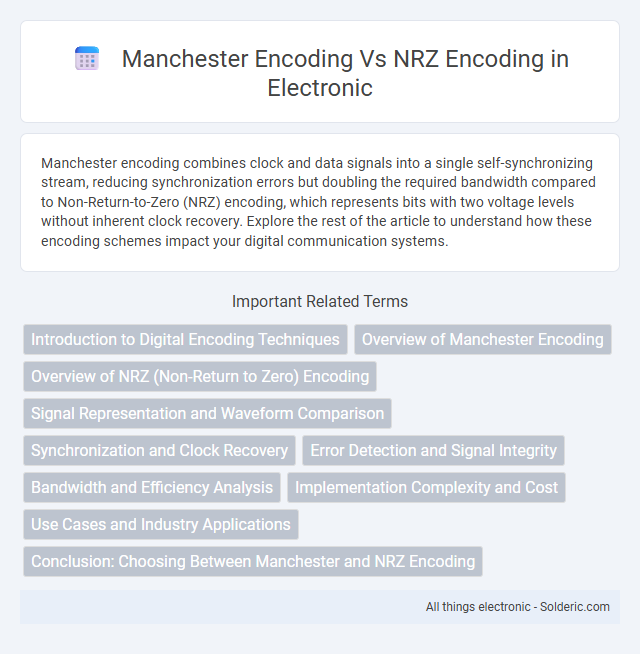Manchester encoding combines clock and data signals into a single self-synchronizing stream, reducing synchronization errors but doubling the required bandwidth compared to Non-Return-to-Zero (NRZ) encoding, which represents bits with two voltage levels without inherent clock recovery. Explore the rest of the article to understand how these encoding schemes impact your digital communication systems.
Comparison Table
| Feature | Manchester Encoding | NRZ Encoding |
|---|---|---|
| Signal Type | Self-clocking, transition-based | Non-return to zero, level-based |
| Clock Synchronization | Embedded, via mid-bit transitions | Requires separate clock or synchronization |
| Bandwidth Requirement | High (twice the bit rate) | Lower (equal to bit rate) |
| Error Detection | Easy due to transitions | Difficult, lacks inherent transitions |
| Signal Complexity | More complex waveform | Simple waveform |
| Power Consumption | Higher, due to frequent transitions | Lower, fewer transitions |
| Application | Ethernet (10BASE-T), RFID | Serial communication, storage devices |
Introduction to Digital Encoding Techniques
Manchester encoding combines clock and data signals into a single self-synchronizing stream, improving error detection and timing accuracy in digital communication. NRZ (Non-Return-to-Zero) encoding represents binary data as distinct voltage levels without a timing signal, offering simplicity but susceptibility to synchronization issues over long transmissions. Understanding these techniques helps you choose the optimal encoding for efficient and reliable data transfer in various digital systems.
Overview of Manchester Encoding
Manchester encoding combines clock and data signals by representing each bit with a transition at the midpoint, ensuring reliable synchronization and error detection. Unlike NRZ encoding, which uses distinct voltage levels without guaranteed transitions, Manchester encoding inherently provides timing information, making it ideal for synchronous communication systems. Your systems benefit from Manchester's robustness in noisy environments, improving data integrity over long distances.
Overview of NRZ (Non-Return to Zero) Encoding
NRZ (Non-Return to Zero) encoding transmits data by maintaining a constant voltage level for the entire bit duration, representing binary '1' and '0' as distinct, steady signals. This method simplifies transmitter design and conserves bandwidth but struggles with synchronization issues due to long sequences of identical bits. NRZ encoding is widely used in serial communication but often requires additional mechanisms to manage clock recovery effectively.
Signal Representation and Waveform Comparison
Manchester encoding represents each bit with a transition at the midpoint of the interval, combining clock and data signals for synchronization, while NRZ encoding maintains a constant voltage level throughout the bit interval with no inherent clock signal. Manchester waveform alternates within the bit period, ensuring frequent signal transitions that help in timing recovery, whereas NRZ waveform stays high or low, resulting in fewer transitions and potential synchronization challenges. Your choice between Manchester and NRZ depends on the trade-off between synchronization reliability and bandwidth efficiency.
Synchronization and Clock Recovery
Manchester encoding embeds clock information within the data signal by transitioning at the midpoint of each bit period, enabling reliable synchronization and clock recovery without an external clock. NRZ encoding lacks inherent clock transitions, making synchronization challenging and often requiring additional mechanisms like phase-locked loops or separate clock signals for accurate clock recovery. Consequently, Manchester encoding enhances synchronization robustness in noisy or varying transmission conditions compared to NRZ encoding.
Error Detection and Signal Integrity
Manchester encoding inherently provides better error detection and signal integrity by embedding a transition in the middle of each bit period, which facilitates synchronization and makes it easier to detect timing errors. Unlike NRZ encoding, which can suffer from long runs of identical bits causing baseline wander and clock recovery issues, Manchester encoding avoids DC bias and allows for more reliable signal interpretation over noisy channels. The balanced nature of Manchester encoding improves signal integrity and reduces bit error rates in communication systems.
Bandwidth and Efficiency Analysis
Manchester encoding requires higher bandwidth due to its self-clocking nature, effectively doubling the signal frequency compared to NRZ encoding. NRZ encoding is more bandwidth-efficient as it transmits one bit per signal change without additional transitions, allowing more data to pass through a limited bandwidth. However, Manchester encoding offers improved synchronization at the cost of bandwidth and lower spectral efficiency.
Implementation Complexity and Cost
Manchester encoding requires more complex circuitry due to the necessity of precise timing synchronization and a higher transition rate per bit, leading to increased implementation cost compared to NRZ encoding. NRZ encoding benefits from simpler hardware design and lower power consumption since it represents data with constant voltage levels without mandatory mid-bit transitions. Consequently, NRZ is more cost-effective for applications prioritizing lower complexity and budget constraints, while Manchester encoding is favored where robust synchronization and error detection are critical despite higher expenses.
Use Cases and Industry Applications
Manchester encoding is widely used in Ethernet networking and RFID systems due to its self-clocking property, which facilitates data synchronization and error detection. NRZ encoding is commonly applied in high-speed serial communication and storage devices, offering efficient bandwidth utilization but requiring additional synchronization methods. Your choice between these encoding schemes should consider the need for synchronization robustness versus bandwidth efficiency in applications like data transmission and digital storage.
Conclusion: Choosing Between Manchester and NRZ Encoding
Manchester encoding provides robust synchronization with a self-clocking signal ideal for environments prone to timing errors, while NRZ encoding offers higher data rates and simpler implementation due to its straightforward voltage-level representation. Your choice depends on the application's need for synchronization accuracy versus bandwidth efficiency and system complexity. For noise-sensitive or long-distance communication, Manchester is preferred, whereas NRZ suits high-speed, short-range data transfer.
Manchester encoding vs NRZ encoding Infographic

 solderic.com
solderic.com